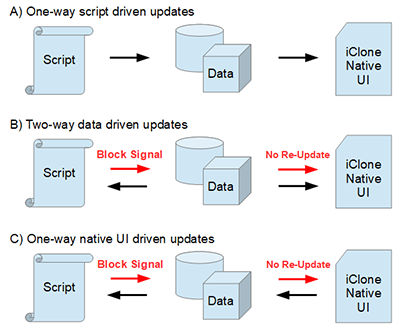Difference between revisions of "IC Python API:Linked Controls"
From Reallusion Wiki!
Chuck (RL) (Talk | contribs) m |
Chuck (RL) (Talk | contribs) m |
||
| Line 9: | Line 9: | ||
# Commands issued from the script in the form of custom user controls first updates the data model in the scene (such as prop transformations) and iClone handles the rest by updating the native UI parameters with no knowledge of the script's existence. This form of interaction is the simplest and most straightforward of the three. | # Commands issued from the script in the form of custom user controls first updates the data model in the scene (such as prop transformations) and iClone handles the rest by updating the native UI parameters with no knowledge of the script's existence. This form of interaction is the simplest and most straightforward of the three. | ||
| − | |||
# Changes to the data model are reflected back onto native UI parameters as well as any receiving linked custom user controls instantiated by scripts. Since data updates are written to the custom user controls which are, in turn, linked to the data model; the signals back to the data model must be blocked to prevent a double update to the data model and the native controls. | # Changes to the data model are reflected back onto native UI parameters as well as any receiving linked custom user controls instantiated by scripts. Since data updates are written to the custom user controls which are, in turn, linked to the data model; the signals back to the data model must be blocked to prevent a double update to the data model and the native controls. | ||
| − | |||
# Changes to the native controls drive changes to the data model which, in turn, drive the linked custom user controls instantiated by scripts. Similar to the mechanism mentioned above, the returning signal must be blocked to prevent a double update to the data model and native controls. | # Changes to the native controls drive changes to the data model which, in turn, drive the linked custom user controls instantiated by scripts. Similar to the mechanism mentioned above, the returning signal must be blocked to prevent a double update to the data model and native controls. | ||
One can derive a unified premise for the aforementioned scenarios into one simple rule: Returning signals on all data model updates to the script must be blocked to prevent double updates to the data model. | One can derive a unified premise for the aforementioned scenarios into one simple rule: Returning signals on all data model updates to the script must be blocked to prevent double updates to the data model. | ||
Revision as of 21:28, 15 August 2019
- Main article: RL Python Samples.
Making a custom interface to drive common object properties such as transform values is a commonplace operation. Problems arise however, when custom interfaces come in conflict with iClone's native controls implementation. To resolve this conflict of multiple operators, the custom controls much be in sync with the native controls and vice versa via a scripted link.
Linked interactions happen in 3 ways:
- Commands issued from the script in the form of custom user controls first updates the data model in the scene (such as prop transformations) and iClone handles the rest by updating the native UI parameters with no knowledge of the script's existence. This form of interaction is the simplest and most straightforward of the three.
- Changes to the data model are reflected back onto native UI parameters as well as any receiving linked custom user controls instantiated by scripts. Since data updates are written to the custom user controls which are, in turn, linked to the data model; the signals back to the data model must be blocked to prevent a double update to the data model and the native controls.
- Changes to the native controls drive changes to the data model which, in turn, drive the linked custom user controls instantiated by scripts. Similar to the mechanism mentioned above, the returning signal must be blocked to prevent a double update to the data model and native controls.
One can derive a unified premise for the aforementioned scenarios into one simple rule: Returning signals on all data model updates to the script must be blocked to prevent double updates to the data model.


